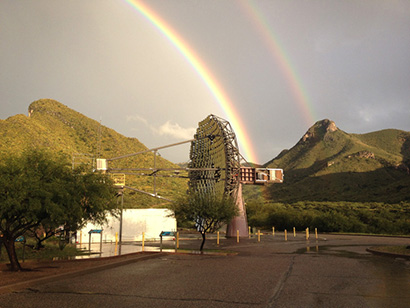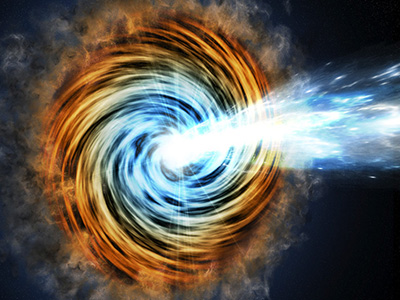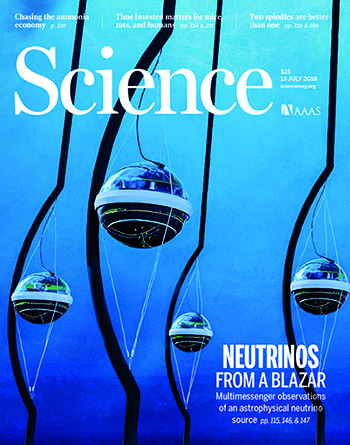The VERITAS array has confirmed the detection of gamma rays from the vicinity of a supermassive black hole. While these detections are relatively common for VERITAS, this black hole is potentially the first known astrophysical source of high-energy cosmic neutrinos, a type of ghostly subatomic particle.
On September 22, 2017, the IceCube Neutrino Observatory, a cubic-kilometer neutrino telescope located at the South Pole, detected a high-energy neutrino of potential astrophysical origin. However, the observation of a single neutrino by itself is not enough for IceCube to claim the detection of a source. For that, scientists needed more information.
Very quickly after the detection by IceCube was announced, telescopes around the world including VERITAS (which stands for the “Very Energetic Radiation Imaging Telescope Array System”) swung into action to identify the source. The VERITAS, MAGIC, and H.E.S.S. gamma-ray observatories all looked at the neutrino position. In addition, two gamma-ray observatories that monitor much of the sky at lower and higher energies also provided coverage.
These follow-up observations of the rough IceCube neutrino position suggest that the source of the neutrino is a blazar, which is a supermassive black hole with powerful outflowing jets that can change dramatically in brightness over time. This blazar, known as TXS 0506+056, is located at the center of a galaxy about 4 billion light years from Earth.
"We know that the blazar jet is accelerating particles to very high energies, but it is difficult to tell from gamma rays alone if it is accelerating just electrons or also protons and heavier nuclei," said David Williams, adjunct professor of physics at UC Santa Cruz and the Santa Cruz Institute for Particle Physics (SCIPP) and a member of the VERITAS collaboration. "If the blazar is a neutrino source, that's a smoking gun for protons, because high-energy protons colliding with gas produce pions, which decay into neutrinos," he said.
Initially, NASA’s Fermi Gamma-ray Space Telescope observed that TXS 0506+056 was several times brighter than usually seen in its all-sky monitoring. Eventually, the MAGIC observatory made a detection of much higher-energy gamma rays within two weeks of the neutrino detection, while VERITAS, H.E.S.S., and HAWC did not see the blazar in any of their observations during the two weeks following the alert.
Given the importance of higher-energy gamma-ray detections in identifying the possible source of the neutrino, VERITAS continued to observe TXS 0506+056 over the following months, through February 2018, and revealed the source but at a dimmer state than what was detected by MAGIC.
“The VERITAS detection shows us that the gamma-ray brightness of the source changes, which is a signature of a blazar,” said Wystan Benbow of the Smithsonian Astrophysical Observatory (SAO), which operates and manages VERITAS. “Finding a link between an astrophysical source and a neutrino event could open yet another window of exploration to the extreme universe.”
Cosmic rays
The detection of gamma rays coincident with neutrinos is tantalizing, since both particles must be produced in the generation of cosmic rays. Since they were first detected over 100 years ago, cosmic rays—highly energetic particles that continuously rain down on Earth from space—have posed an enduring mystery. What creates and launches these particles across such vast distances? Where do they come from?
“The potential connection between the neutrino event and TXS 0506+056 would shed new light on the acceleration mechanisms that take place at the core of these galaxies and provide clues on the century-old question of the origin of cosmic rays,” said coauthor and VERITAS spokesperson Reshmi Mukherjee of Barnard College, Columbia University in New York.
“Astrophysics is entering an exciting new era of multi-messenger observations, in which celestial sources are being studied through the detection of the electromagnetic radiation they emit across the spectrum, from radio waves to high-energy gamma rays, in combination with non-electromagnetic means, such as gravitational waves and high-energy neutrinos,” said coauthor Marcos Santander of the University of Alabama in Tuscaloosa, who led the study.
A paper describing the deep VERITAS observations of TXS 0506+056 (“VERITAS Observations of the BL Lac Object TXS 0506+056”) has been accepted for publication in Astrophysical Journal Letters and appears online on July 12, 2018. A paper on the IceCube and initial gamma-ray observations, including VERITAS’s, appears in the latest issue of the journal Science.
"This is a terrific step forward in multi-messenger astrophysics," said Williams, who worked on the analysis of the VERITAS data and coordinated the VERITAS contributions to the Science paper.
VERITAS is a ground-based facility located at the SAO’s Fred Lawrence Whipple Observatory in southern Arizona. It consists of an array of four 12-meter optical telescopes that can detect gamma rays via the extremely brief flashes of blue “Cherenkov” light created when gamma rays are absorbed in the Earth’s atmosphere. The VERITAS Collaboration consists of about 80 scientists from 20 institutions in the United States, Canada, Germany and Ireland.
The Fermi-LAT Collaboration, which also played an important role in this research, includes researchers at the Santa Cruz Institute for Particle Physics at UC Santa Cruz.





